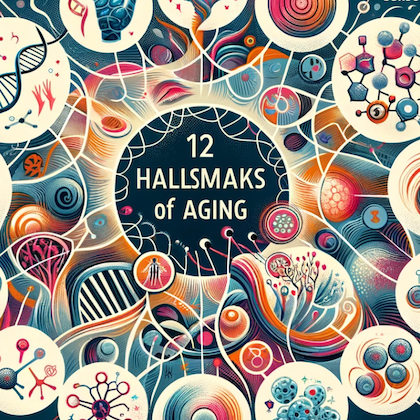
Exploring the 12 Hallmarks of Aging: Keys to Longevity
Share
Aging is a complex, multifaceted process that affects every living organism. Over the years, scientific research has delved deeply into understanding how and why we age, leading to the identification of specific biological markers or "hallmarks" of aging. These hallmarks help explain the underlying mechanisms that drive the aging process and offer insights into potential interventions for age-related diseases and longevity. Our previous article on the 9 hallmarks of aging gets a bit of a refresh here with 3 more hallmarks being added. These hallmarks shed light on factors that contribute to the natural aging process and what this means for future therapies and health-span extension.
-
Genomic Instability: Genomic instability refers to the accumulation of damage in DNA over time, leading to mutations and alterations in genetic information. This damage can be caused by environmental factors, such as UV radiation and toxins, or internal processes like DNA replication errors. The repair mechanisms that usually fix this damage become less efficient as we age, contributing to the development of age-related diseases, including cancer.
-
Telomere Attrition: Telomeres are protective caps at the ends of chromosomes that shorten with each cell division. Once they reach a critically short length, cells enter a state of senescence or apoptosis, leading to tissue dysfunction and aging. Telomere attrition acts as a biological clock, limiting the number of times a cell can divide and thus contributing to aging.
-
Epigenetic Alterations: Epigenetic alterations involve changes in gene expression that do not modify the DNA sequence itself but can be inherited through cell division. These changes can be influenced by lifestyle and environmental factors and accumulate over time, affecting aging and disease susceptibility by disrupting normal cell function.
-
Loss of Proteostasis: Proteostasis involves the balance of protein synthesis, folding, trafficking, and degradation. As we age, the systems responsible for maintaining proteostasis become less efficient, leading to the accumulation of misfolded or aggregated proteins. This can disrupt cellular function and is a feature of many age-related diseases, such as Alzheimer's disease.
-
Deregulated Nutrient Sensing: The body's ability to sense and respond to nutrients changes with age, affecting metabolic pathways that are crucial for health and longevity. Deregulation of nutrient sensing pathways, such as insulin/IGF-1 signaling, can lead to metabolic diseases and contribute to the aging process.
-
Mitochondrial Dysfunction: Mitochondria are the powerhouses of the cell, providing energy through ATP. With age, mitochondrial function declines, leading to decreased energy production and increased oxidative stress. This not only affects cellular energy levels but also contributes to the accumulation of DNA damage and cellular aging.
-
Cellular Senescence: Senescent cells are cells that have ceased dividing but do not die. They accumulate with age and secrete inflammatory factors that can damage surrounding tissues. Clearing senescent cells or preventing their accumulation has been shown to alleviate age-related tissue dysfunction.
-
Stem Cell Exhaustion: Stem cells have the ability to self-renew and differentiate into various cell types. As we age, the regenerative capacity of stem cells declines, leading to impaired tissue repair and regeneration, contributing to aging and the development of age-related diseases.
-
Altered Intercellular Communication: Aging is associated with changes in the signals that cells use to communicate with each other. These changes can lead to chronic inflammation (inflammaging), impaired immune response, and tissue dysfunction, all of which are hallmarks of aging.
-
Inflammation: Chronic inflammation increases with age and is a key driver of the aging process and many age-related diseases. It results from a combination of factors, including cellular senescence and altered intercellular communication.
-
Adaptation to Stress: The ability of cells to respond to stress declines with age, affecting the repair of damaged proteins and DNA. Enhancing stress response mechanisms may help to mitigate some aspects of aging and improve cellular resilience.
-
Altered Extracellular Matrix: The extracellular matrix (ECM) provides structural support to tissues and organs. With age, the ECM undergoes changes that affect tissue function and integrity, contributing to the aging process.
The 12 hallmarks of aging provide a framework for understanding the complexity of the aging process and its impact on biological systems. By targeting these hallmarks, researchers are developing interventions to delay aging, improve health-span, and prevent age-related diseases. As we continue to unravel the mysteries of aging, we move closer to the possibility of healthier, longer lives.
This article aims to shed light on the intricate processes behind aging, offering a foundation for future discussions and research into how we can live healthier, longer lives. From nutrition plans like the longevity diet and mediterranean diet to styles of fasting and other therapies to promote health and longevity. The 12 hallmarks of aging are not only pivotal for scientific understanding but also offer potential pathways for interventions that could significantly impact our approach to age-related health and longevity.
